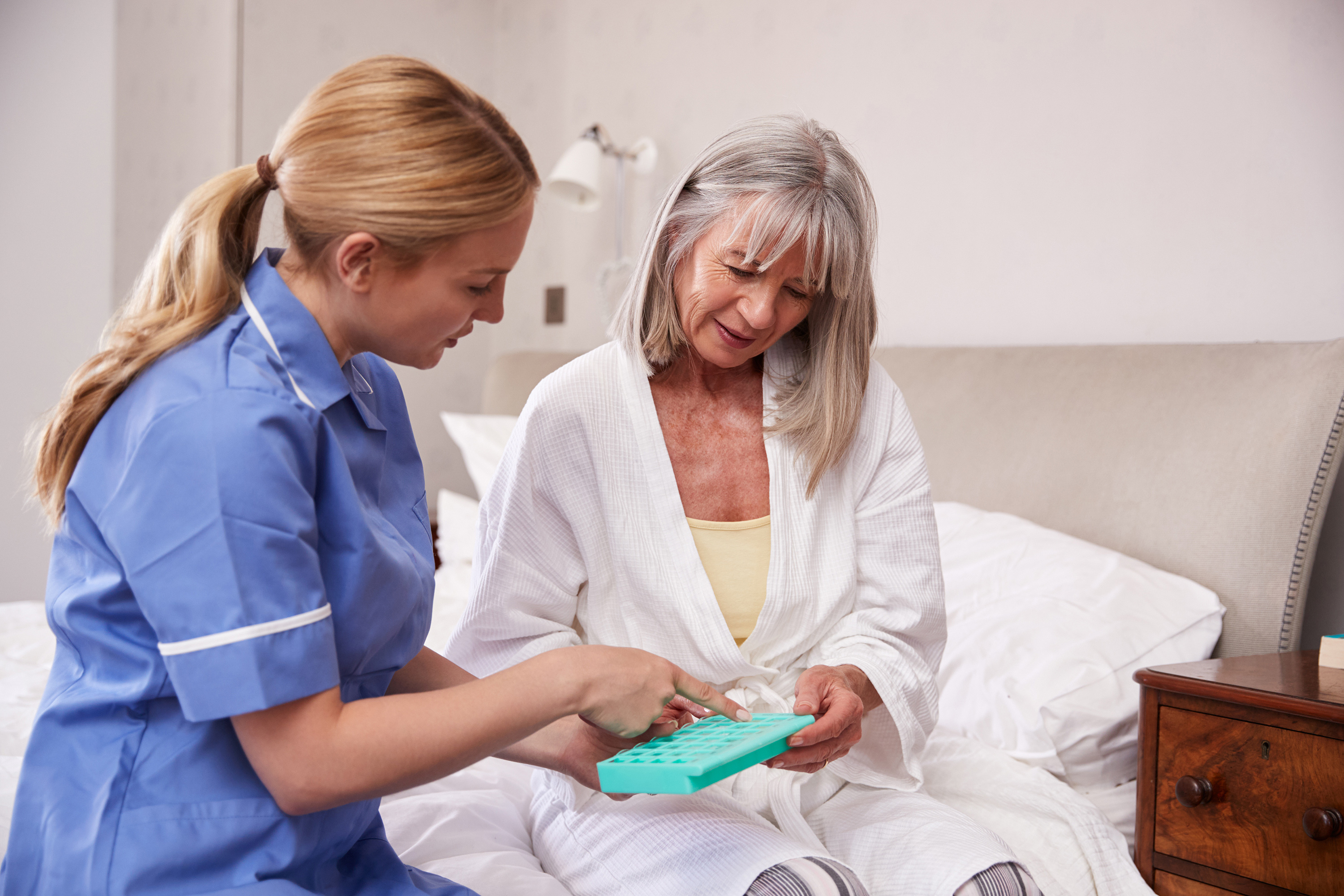Antimicrobial Technology for Enhanced Hygiene in Care Homes

There are numerous news stories on an almost weekly basis talking about care homes struggling with hygiene management. This reporting highlights a critical issue within the care home industry where maintaining a high level of cleanliness and hygiene is essential for the well-being of both residents and staff who live and work in close proximity. Despite rigorous cleaning protocols, bacteria and other microorganisms can still lurk within these communal living spaces, posing hygiene challenges for care home operators and healthcare workers.
Antimicrobial additive technology presents a promising solution to this ongoing challenge by actively inhibiting the proliferation of microorganisms on surfaces, materials, and medical devices commonly found in care homes. This antimicrobial technology can be integrated into a wide range of products and surfaces. By incorporating antimicrobial technology into key touchpoints throughout the care home environment, such as countertops, door handles, and medical devices, facilities can significantly enhance their microbial control efforts. This not only helps to create a more hygienic living environment for residents but also contributes to an improved working environment for staff. The integration of antimicrobial technology perfectly complements the frequent cleaning and disinfection that already takes place, providing passive hygiene that works around the clock.
Understanding Antimicrobial Additive Technology

Antimicrobial additive technology is most commonly integrated into products and surfaces at the point of manufacture. During the manufacturing process, antimicrobial additives are added directly into the raw materials. These antimicrobial additives are specifically designed to inhibit the growth and spread of microorganisms, such as bacteria, viruses, and fungi. The technology ensures that the antimicrobial properties are inherent to the product itself, providing continuous product protection without the need for additional applications or treatments at a later date. This proactive approach offers sustained product protection against microbial growth throughout the usable lifespan of a product. By maintaining a consistently high level of hygiene, antimicrobial additive technology creates an improved environment for vulnerable populations and staff with care homes.
One of the most effective antimicrobial technologies uses silver ions. Silver-ion technology has been extensively studied and proven to be highly effective in disrupting microbial activity. Silver ions work by interfering with key microbial functions, such as cellular respiration and DNA replication, crucial for the survival and reproduction of microorganisms. When microorganisms come into contact with silver ions, these ions penetrate the cell walls and disrupt vital cellular processes, leading to the suppression of microbial growth and proliferation.
Antimicrobial coatings can also be applied to product surfaces to create a protective barrier against microbial colonisation and delay biofilm formation. These coatings are engineered to form a durable, long-lasting layer, actively inhibiting the attachment and growth of microorganisms. This protective barrier reduces surface contamination by making it difficult for microbes to adhere and multiply. Additionally, antimicrobial coatings help delay the formation of biofilms, which are complex communities of microorganisms that can be particularly challenging to eradicate. By preventing biofilm formation, these coatings enhance the hygiene of surfaces.
Common Touch Points Within a Care Home
- Door Handles and Cupboard Doorknobs: Door handles and cupboard doorknobs are some of the most frequently touched surfaces within a care home environment. Both residents and staff come into contact with these touchpoints multiple times a day, making them highly susceptible to microbial contamination. Each time a door handle or cupboard doorknob is touched, bacteria and other pathogens are transferred. Utilising antimicrobial door handles and cupboard doorknobs can significantly reduce the microbial load on these surfaces. The antimicrobial additives embedded in these handles work around the clock to inhibit the growth and spread of microorganisms.
- Handrails and Grab Bars: Handrails and grab bars are essential for providing stability and support to residents as they move around the care home. These touch points are crucial for safety, especially for those with mobility issues. However, their frequent use means they are also common sites for microbial build up. Handrails and grab bars treated with antimicrobial technology can effectively inhibit the growth of bacteria, viruses, and fungi on these surfaces.
- Countertops and Surfaces: Countertops and surfaces in communal areas, dining rooms, kitchens, and resident rooms are constantly in use and are frequently touched by many individuals on a daily basis. These surfaces are hotspots for bacteria and other pathogens. The use of antimicrobial technology within countertops and other surfaces can greatly minimise microbial colonisation. The antimicrobial properties work to continuously protect these areas from bacterial growth, ensuring a higher level of hygiene. This is particularly important in areas where food is prepared and served, as well as in social spaces where residents gather and interact.
- Medical Equipment and Devices: Medical equipment and devices, such as blood pressure cuffs, thermometers, bed rails, and mobility aids, are integral to providing quality care to residents. However, these items are also prone to microbial contamination due to their frequent use. Ensuring that medical equipment and devices are treated with antimicrobial technology can help prevent the transmission of harmful microorganisms.
- Textiles and Furnishings: Textiles, including bedding, curtains, towels, and upholstered furniture, are ubiquitous in care homes and are frequently handled by residents and staff. The porous nature of textiles makes them particularly vulnerable to microbial contamination. Incorporating antimicrobial technology into these textiles can inhibit the growth of bacteria, fungi, and other pathogens.
- Wall Panelling and Wall Coverings: Wall panelling and wall coverings are often overlooked as potential sources of microbial contamination, despite being regularly touched and in close proximity to residents and staff. Antimicrobial technology within these surfaces helps to mitigate the risk of microbial growth and surface contamination.
- Light Switches and Electrical Controls: Light switches and other electrical controls are frequent touchpoints for both residents and staff. These points of contact can easily harbour bacteria and viruses due to their frequent use. Utilising antimicrobial light switches and controls can help to reduce the spread of microorganisms.
- Remote Controls and Keyboards: Remote controls for televisions and other devices, as well as computer keyboards and mice, are commonly used and can be touched by multiple people throughout the day. These items are well known to be hotspots for microbial contamination. Antimicrobial treatments for these devices can inhibit the growth of bacteria and other pathogens, promoting better hygiene.
- Telephones: Shared telephones in common areas and resident rooms are frequently used and can be significant sources of microbial contamination. Antimicrobial telephone handsets will help to reduce microbial contamination on these common touch points.
- Bathroom Fixtures: Taps, toilet flush handles, and soap dispensers in bathrooms are high-contact surfaces that can harbour a variety of microorganisms. Incorporating antimicrobial technology into these fixtures can help maintain an improved level of hygiene.
- Dining Utensils and Trays: In care homes, dining utensils and trays are handled by many people, including residents and staff. Antimicrobial alternatives of these items are available, and they can inhibit microbial growth ensuring safer mealtimes.
By converting these common touch points to antimicrobial alternatives, care homes can create a more hygienic environment for both residents and staff.
Rationale for Antimicrobial Product Protection

The implementation of antimicrobial technology in care home environments serves several important purposes:
- Control: Targeting high-touch surfaces and areas prone to microbial contamination with antimicrobial technology is crucial for reducing the proliferation of pathogens. This technology works by continuously inhibiting the growth and spread of microorganisms, including bacteria, viruses, and fungi. By incorporating antimicrobial agents into frequently touched items such as door handles, handrails, and medical equipment, care homes can create a more controlled environment where the risk of microbial transmission is significantly lowered.
- Enhanced Hygiene Standards: By actively suppressing microbial growth on surfaces and materials, antimicrobial technology reinforces existing cleaning and disinfection protocols. This ensures a higher standard of cleanliness and hygiene throughout the care home environment. Regular cleaning and disinfection are essential, but antimicrobial technology adds an extra layer of protection that works around the clock. This continuous protection helps to fill the gaps between cleaning, making sure that surfaces remain as free from pathogens as possible. Consequently, this leads to a more hygienic environment, reducing the overall microbial load and enhancing the effectiveness of regular cleaning practices.
- Resident Well-being: Residents in care homes are particularly vulnerable to infections due to age-related frailty and underlying health conditions such as chronic diseases or weakened immune systems. Protecting high-touch surfaces and frequently used items with antimicrobial additives creates improved resident hygiene and comfort. Additionally, the knowledge that their environment is protected by advanced antimicrobial technology can provide residents and their families with greater peace of mind, contributing to a more comfortable and reassuring living experience.
Furthermore, antimicrobial technology in care homes can reduce the use of harsh chemical disinfectants, which can sometimes be irritating to both residents and staff. By decreasing the frequency and intensity of cleaning required to maintain hygiene standards, antimicrobial technology supports a more sustainable and resident-friendly approach. Overall, the rationale for implementing antimicrobial product protection in care homes is rooted in its ability to enhance control over microbial contamination, elevate hygiene standards, and significantly improve the well-being of residents.
Regulatory Considerations and Standards
The implementation of antimicrobial technology in care home environments is subject to regulatory oversight and adherence to industry standards. Regulatory agencies, such as the Environmental Protection Agency (EPA) in the United States and the European Chemicals Agency (ECHA) in Europe, evaluate the safety and efficacy of antimicrobial products.
Care home operators should ensure that antimicrobial products selected for use comply with relevant regulatory requirements and possess appropriate certifications or approvals. Additionally, facilities should adhere to recommended guidelines for the proper application, maintenance, and monitoring of antimicrobial-treated surfaces to maximise efficacy.
Best Practices for Implementation
To optimise the effectiveness of antimicrobial technology in care home environments, adherence to best practices is essential. Key considerations include:
- Routine Maintenance: Even with the implementation of antimicrobial technology, it is crucial to continue regular cleaning and maintenance schedules. This means adhering to established cleaning protocols to ensure that surfaces and high-touch areas are free from visible dirt and grime, which can harbour microorganisms. Routine maintenance involves not just daily cleaning but also periodic deep cleaning to address any buildup of contaminants. This comprehensive approach ensures that antimicrobial products can function effectively, providing continuous protection against microbial growth.
- Staff Training: Providing comprehensive training to staff on antimicrobial products and the benefits they bring to care home environments is vital. Staff members should be well-informed about how antimicrobial technology works, and the specific products being used. Educating staff about the role of antimicrobial agents in reducing infections and improving resident safety can also enhance their commitment to maintaining high hygiene standards. Ensure that all staff members stay up-to-date with the latest best practices and innovations in antimicrobial technology.
- Monitoring and Evaluation: Establishing protocols for monitoring microbial contamination levels and evaluating the effectiveness of antimicrobial interventions over time is crucial. This involves regular testing of surfaces and environments to detect any microbial presence and assess the performance of antimicrobial treatments. Care homes should implement a systematic approach to collecting and analysing data on contamination levels and the overall impact of antimicrobial technologies on hygiene standards. Continuous monitoring allows for the identification of any gaps or issues in the implementation process, enabling timely corrective actions. Evaluation should also include feedback from staff and residents to gauge the perceived effectiveness and acceptance of antimicrobial measures. By maintaining a robust monitoring and evaluation system, care homes can ensure that antimicrobial technologies are delivering the intended benefits.
By incorporating these best practices into their daily operations, care homes can maximise the benefits of antimicrobial technology. This comprehensive approach not only enhances the immediate effectiveness of antimicrobial products but also ensures their long-term sustainability and impact. It fosters a culture of hygiene, where both staff and residents are actively engaged in maintaining a clean environment. The integration of routine maintenance, thorough staff training, and diligent monitoring reinforces the protective capabilities of antimicrobial technology and contributes to a higher standard of care.
Antimicrobial technology represents a potent ally in care home environments. By leveraging the antimicrobial technology, care homes can inhibit microbial growth and create more hygienic living environments for residents and staff alike. Successful implementation requires careful consideration of product selection, regulatory compliance, and adherence to best practices for maintenance and monitoring. As the field of antimicrobial technology continues to evolve, ongoing research and innovation will further enhance its efficacy and applicability in care home settings, ultimately advancing the goal of optimal hygiene and resident care.
What Next?
🔗 Follow us on Social Media, here is our LINK TREE
✉️ See how our additive technology can benefit your business by CONTACTING US
🦠 Find out more about Biomaster Antimicrobial Technology HERE
🎥 Watch our video on how Biomaster works WATCH NOW
📰 Subscribe to our Newsletter - SUBSCRIBE
← Back to blog



